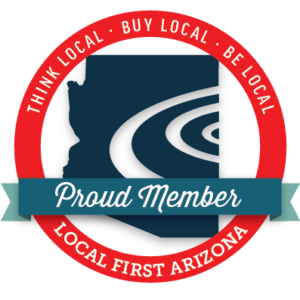One of our guiding principles at Dirty Freehub is “spend where your ride”. We think it is critically important that when you are visiting and riding in the backcountry that you spend some money in the local, supporting towns. That could be for gas, groceries, bike parts, a coffee, or a burger and beer. But not all of these dollars have the same impact!
In the podcast below with Thomas Barr, the Vice President of Business Development for Local First Arizona, you will learn why some spending has a greater impact than other spending. Local First Arizona is a nonprofit organization committed to building vibrant, inclusive, and sustainable communities.
How to Identify Local

- Ask! When you walk into a shop, ask an employee if they are locally owned. Almost every employee knows if a shop is locally owned. They were maybe hired by the owner, or the owner works at the shop, or that the owner lives upstairs in the loft. This is the best indicator.
- Look for a Sticker. Many states and towns have a local-first initiative. These are usually marketed by a sticker on the window.
- Do a quick Google search. Most stores that are locally owned share their story somewhere on their web page, usually in the “About” section.
The Importance of Local
- Small businesses generate $68 of local economic return for every $100 spent with them.
- Small businesses donate 250% more than large businesses to community causes.
- Local business generates 70% more local economic activity per square foot than big-box retail.
- Buying local reduces transportation miles by 26% (i.e. think climate change).
[Ref: Sustainable Connections]
The Local Effect Scorecard
- local employees
- local ownership
- locally sourced products
- locally sourced services like bookkeeping, web development, graphic design, and printing.
The best local: local ownership, local employees, locally sourced products, and locally sourced services.

 Behind every route is scouting, mapping, storytelling, and a whole lot of pedal power.
Behind every route is scouting, mapping, storytelling, and a whole lot of pedal power.